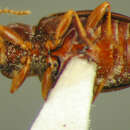Comprehensive Description
provided by Smithsonian Contributions to Zoology
Tachyta hispaniolae (Darlington)
Tachys hispaniolae Darlington, 1934:77 [holotype, female, MCZ; type-locality: Grande Riviere, Haiti].
DIAGNOSIS.—The strong microreticulation of the dorsal surface and the pale elytral spots are distinctive in the genus.
DESCRIPTION.—Form (Figure 1): Elongate, broad, and subconvex; head broad and subconvex with very prominent eyes.
Color: Shiny rufous with testaceous labrum and elytral spots, one spot at apical third of each elytron; appendages testaceous; apex and sides of elytra in some specimens dark rufous.
Head (Figure 81): Broad and subconvex, equal across eyes to width of pronotum across anterior angles; frontal furrows shallow and poorly defined, lateral carina moderately well developed, fovea surrounding base of anterior supraorbital seta very shallow; front between eyes finely and sparsely punctulate, punctulae not arranged in transverse band; eyes large and very prominent. Mentum (Figure 80) deeply sulcate anteriorly, buccal fissure complete; submentum with shallow median sulcus.
Pronotum (Figure 82): Transverse, disc sub-convex, laterally more strongly convex; sides abruptly sinuate near hind angles, margins moderately broadly reflexed and sulcate from hind angle to anterior lateral seta, less so to anterior angle, surface laterobasally carinate, carina short and not well developed; hind angles acute, denticulate; basal transverse impression well engraved laterally, narrowly interrupted medially; median longitudinal line finely impressed; anterior angles not at all produced.
Elytra (Figure 83): Sutural interneur entire, striate-punctate, and moderately deeply impressed throughout, interneurs 2 to 7 less or not striate but moderately strongly punctate, the lateral ones less so, interneur 8 entire and sulcate-punctate throughout its length; humeral margin rounded to base of interneur 5, margin broadly reflexed and explanate from humerus to plica, edge setulose behind humerus; chaetotaxy as in T. picina members except Ed 3 located on same plane as Eo 4; plica well developed and visible externally.
Microsculpture (Figures 84–86): Well-impressed transversely arranged meshes, more nearly isodiametric on head, much less so on pronotum and almost scaly on elytra.
Genitalia: Male (Figure 72) with internal sac moderately darkly pigmented, with ventral rod of medium length, dorsal rod elongate and shallowly C-shaped, and C-sclerite large; phallus with apex attenuate (1 examined); female as in T. falli (2 examined).
Size: Length, 2.56 to 2.76 mm; width, 1.12 to 1.16 mm, 2 specimens measured.
VARIATION.—See color, above.
NATURAL HISTORY.—Darlington found these beetles in June in the foothills of the central Cordillera of the Dominican Republic.
DISTRIBUTION (Figure 88).—These beetles are found only on the Greater Antillian island of Hispaniola, both in Haiti and the Dominican Republic.
The pseudovirens group
The single member of this group is very close to the preceding species, but lacks the elongate ventral sclerite of the male genitalia. In this species, the endophallic sclerite is short and medial. In addition, the pronotal carinae are very short and the median line is finely impressed.
Members of this monotypic group are found under bark of dead trees in a small area of western Africa.
- bibliographic citation
- Erwin, Terry L. 1975. "Studies of the subtribe Tachyina (Coleoptera: Carabidae: Bembidiini), Part III: Systematics, phylogeny, and zoogeography of the genus Tachyta Kirby." Smithsonian Contributions to Zoology. 1-68. https://doi.org/10.5479/si.00810282.208

